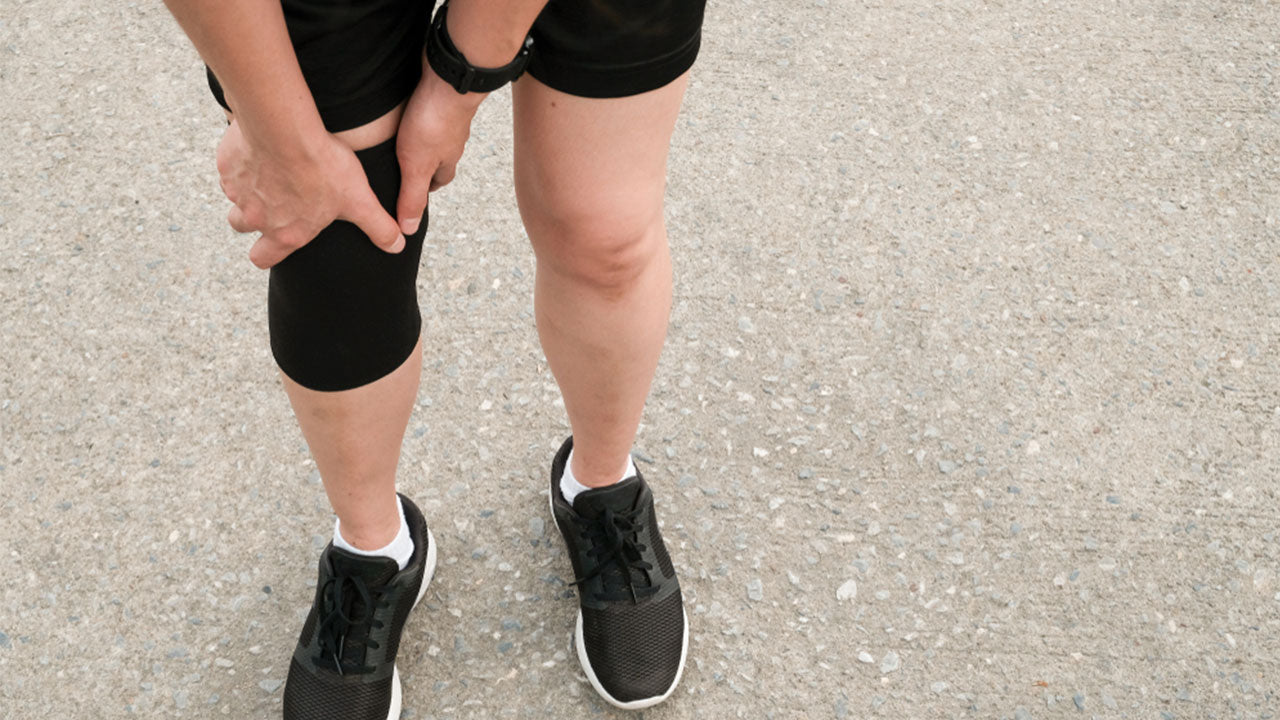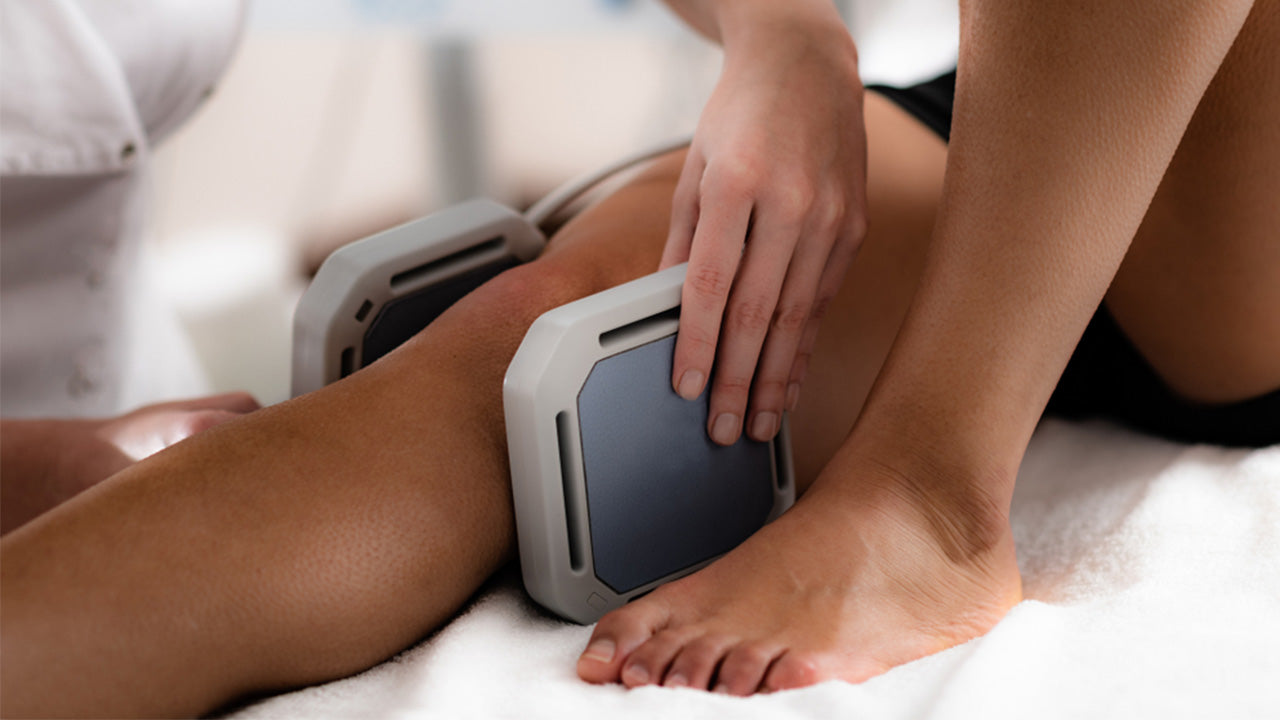Knee Sleeves and Support Wraps: When You Need Them and How to Select the Best (Top 7 Brands)
 By: by Amino Science
By: by Amino Science

Our knee joints are biological engineering marvels, but they're also extremely prone to injury, especially in those who lead active lifestyles or push their bodies to the limit. From ACL tears to worn-down cartilage, the more we ask of our knees the more potential there is for long-term damage. Learn about how knee sleeves can offer support to help avoid injury, how knee wraps can protect you while you heal from injury, plus the top seven best brands and their key features so you can select the perfect brace for your needs.
Common Knee Injuries
The knee is a hinge joint made up of bones, cartilage, tendons, and ligaments that allow us to walk, run, jump, squat, and sit.
The bones include the femur (thighbone), the tibia (shinbone), and the patella (kneecap). Between the thigh and shinbone are caps of cartilage to keep the bones from grinding together, and throughout the knee joint are four ligaments and various tendons that crisscross and stabilize the whole operation.
With so many moving parts, knee damage is a frequent injury seen in sports medicine and accident care. Here are the most common knee injuries.
1. Bone Fractures
A fracture to any of the bones involved in the knee can be debilitating, but the most common break is the kneecap, which is there to act as a shield to the rest of the joint.
Kneecap breaks are most often caused by falls that land on the kneecaps, or in instances of a car accident when the knees are the first part of the body to hit the dashboard.
Those with a condition such as osteoporosis are not only more prone to falls but may break their kneecaps without an impact injury due to the weakness of the bones if the disease has advanced far enough.
2. ACL Tears
The ACL is the anterior cruciate ligament that runs diagonally just behind the kneecap. The injury grade is measured from 1 to 3 in severity and may require ligament replacement surgery if the injury is too severe to stitch and allow to heal on its own.
The least amount of injury is a mild sprain, which involves rest and care so it doesn't worsen, while the most amount of injury is a complete and irreparable tear of the ligament. These injuries are very common in sports like soccer and football because they often occur in moments of jump-landing and swift changes in directional movement.
3. Knee Dislocation
Dislocations occur when any of the bones of the knee are out of alignment. Whether due to an accidental slip out of place or a traumatic injury, dislocation of the knee requires medical attention and a knee brace to keep the bones of the knee stable.
4. Meniscus Tears
The menisci of the knee are the cartilage caps on each knee bone that keeps them from rubbing together. A tear in one or both of these caps, whether due to injury or to age-related wear and tear, can be very painful and if left untreated could lead to further worsening injuries.
An age-related injury is known as a degenerative meniscus tear, while a sudden tear to the meniscus may involve a "pop" sound or sensation, pain, and swelling. This sort of injury needs medical attention, and treatment may involve a meniscus tear brace.
5. Bursitis
Bursa sacs exist throughout the body between many of our joints. Bursae are fluid-filled sacs that help lubricate and cushion the movements between bones, ligaments, and tendons. If they become irritated, injured, or inflamed, you've got a case of bursitis.
Luckily this condition is usually mended by at-home care and rest, but some may need the area to be aspirated to drain out excess fluid and allow healing to begin. Evaluate your own pain levels and decide whether you think your condition merits medical consultation or intervention.
6. Tendonitis
Tendonitis can happen in your hands, feet, elbows, and knees. It occurs when the tendons that usually slide smoothly back and forth as we move our limbs become inflamed or compressed due to swelling, causing a burning, itching sort of pain and soreness.
Those whose work involves a repetitive movement like typing may utilize wrist wraps to help stabilize the area and reduce injury. The same logic applies to those whose work, workouts, or sporting activities lead to conditions like jumper's knee, which is tendonitis of the patellar tendon (extending from the top of the shinbone to the bottom of the kneecap). Check out some natural anti-inflammatory solutions before turning to over-the-counter NSAIDs if you have tendonitis.
7. Tendon Tears
Tendonitis is often cured by DIY RICE procedures (Rest, Ice, Compress, Elevate), but a tendon tear is as serious as a ligament tear and requires professional medical treatment. A common sports injury, tendon tears also become more frequent as we age due to overactivity or injury.
8. Collateral Ligament Tears
The collateral ligaments attach the shinbone to the thighbone on the inside and outside of the knee: the medial collateral ligament (MCL) on the inside and the lateral collateral ligament (LCL) on the outside.
These injuries are far more common in athletes who play contact sports like football, but can happen to anyone who suffers a collision to the inside or outside of their knee, like a car accident with a side-door impact.
9. PCL Tears
The final of the four knee ligaments is the PCL or posterior cruciate ligament. This is the ligament at the back of the knee that also connects thighbone to shinbone and completes the 4-wall brace that the ligaments hold around the knee joint. It keeps the shinbone from going back too far (so that your knee bends forward only, never backward), and an impact or injury to this ligament can compromise your ability to walk.
10. Iliotibial Band Syndrome
The iliotibial band is on the outside of the knee, a long band that runs from your pelvis, along your outer thigh, and cups just around the knee to attach to your shinbone. Iliotibial band syndrome is an irritation of this band due to overuse, seen most frequently in bicyclists and long-distance runners.

Knee Sleeves Types to Repair and Prevent Injuries
Let's talk about knee support sleeves now, the different kinds and which activities they're best suited for (see the final section of this article for brand recommendations).
Knee sleeves are used to provide support, reduce swelling, and prevent injuries by limiting the knee's range of motion to where it's supposed to be (not side-to-side slipping). There are three thickness levels of compression knee sleeves, each designed to support different activities.
- 3mm thick: The thinnest of the brace types, this knee sleeve is best for endurance, cardio, and agility workouts, as well as long-distance training. It's light enough not to weigh down a marathon runner, but still provides the stabilizing support that can help an athlete avoid injury as the body fatigues.
- 5mm thick: This thickness is best for mixed activity, meaning sports or workouts with varied training that need support and agility in equal amounts. A 5mm knee sleeve is appropriate for triathlon training or CrossFit workouts, good in and out of the gym.
- 7mm thick: These thicker 7mm knee sleeves are made for short, heavy activities like powerlifting. The heavy lifting done by bodybuilders puts an overwhelming amount of pressure on the knees and back, which is why robust knee braces and weightlifting belts are often seen on these titans of the gym to really lock the body in place.
Compression sleeves are good to avoid injuries and to treat them by minimizing swelling and reducing the risk of reinjury when people return to their normal activities. The same sort of products exist as ankle, wrist, and elbow sleeves too.
 What to Look for in a Knee Support Sleeve
What to Look for in a Knee Support Sleeve
In the FAQs surrounding knee sleeves, there are a few key questions that keep arising. Here are some details to consider before you shop around for a pair of knee sleeves, as we want to make sure you're confident in your decision before you head to checkout.
- Thickness: The previous section reviewed the thickness options, so simply ask yourself what you want to do with your knee sleeves—run a marathon, lift weights, or a little bit of everything? That will tell you which thickness to select. In general, the average gym-goer does best with the middle-of-the-road 5mm knee sleeve.
- Structure: You can buy knee sleeves that are open (patella sleeves with a hole for the knee cap), closed (full sleeves), or that come with extra support material like padding, either removable or stitched in orthopedic braces, and extra sling-shot straps for added customizable support.
- Material: Regardless of the brand, most knee sleeves are made using neoprene. There are spandex, silicone, and nylon options available, but neoprene is a synthetic rubber found often in sporting, outdoor, and marine equipment and clothing because it's durable, water-resistant, and easy to clean. This is the material we recommend, especially since neoprene products are usually machine washable.
- Length: This is no one-size-fits-all situation. Longer sleeves mean more compression and better blood flow control, but that length might feel constraining in fast and free activities like CrossFit. Your decision depends on your comfort requirements.
- Price: If you're new to the gym or only recovering from an injury, there are relatively cheap knee sleeves out there (less than $20) that can serve your purpose without breaking the bank. For professional athletes or committed fitness enthusiasts, however, premium knee sleeves can run upwards of $60 to $100—you'd only spend that kind of money if you know exactly what you want and need the best and longest lasting.
- Certification: The USPA, IWF, and IPF are governing organizations of powerlifting competitions in the U.S. and abroad, and you may want to make sure the product you're buying has their seal of approval if you're thinking about competing, or if you just want to make sure you're getting the highest quality products used by the pros.
- Style: A lot of knee sleeves are plain, solid colors that attract little or no attention, but there are also brands that offer bright eye-catching colors and patterned material. It doesn't make any difference to the quality of the product, but maybe if you're choosing between brands and one has a cool camo or pretty floral pattern, the style will be the last straw that makes your decision.

The Top 7 Best Knee Sleeves
Whether you're looking for lifting knee sleeves for strongman exercises, a brace for knee pain relief and blood flow support while healing, or a general gym helper in the form of a knee support sleeve, here are the top seven brands available to choose from.
1. Stoic Knee Sleeves
With a simple, minimalist black design, the Stoic knee sleeve is a neoprene sleeve that comes in four separate sizes with a non-slip interior. Its stitching is triple reinforced, and with 7mm thickness and a length of 30 centimeters, it's a higher-priced model that is approved by the USAPL, USPA, and IPF organizations (so perfect for weightlifters).
2. Rehband RX Knee Support
With seven sizes and a dozen color combos, Rehband has been in business since 1955 providing world-class quality products with Swedish design and European production. They have a unique, patented full-sleeve design with comfort seams using neoprene and textile material for non-slip comfort. They are expensive, however, at about $35 for one sleeve.
3. Fitnessery Knee Sleeves
Fitnessery provides a more inexpensive ($17 for a pair) neoprene sleeve with reinforced stitching and a mesh carrying bag for convenience. If you're looking for your first set of knee sleeves, this is a great beginner's choice that won't break the bank as you experiment with your fitness routine.
4. Bear KompleX Compression Knee Sleeves
While these neoprene sleeves from Bear KompleX are not IPF-approved, they are USPA-approved in 5mm and 7mm varieties. Middling in price between $25 and $60 per pair, the best selling point might be the style choices: colorful camouflage patterns, red and blue bandanas, stars and stripes, Aztec reversible, and more, including plain old black if you don't need flair at the gym.
5. Iron Bull Strength Knee Sleeves
With 7mm neoprene designs perfect for powerlifters, Iron Bull Strength knee sleeves have choices in accent colors, anti-slip pads made of silicone, and an extended length for full support. The only downside is they're not competition-certified by any weightlifting federations, so they're better as a relatively inexpensive choice for amateur lifters.
6. Jupiter Knee Sleeves
Another fun pair of knee sleeves best for the weekend warrior type more than the professional competitor, Jupiter brand knee sleeves are affordable, relatively durable for casual use, and have punk-rock design patterns like black camo and skulls. Made of neoprene just like all our selections, they are easily machine washable.
7. Gymreapers Knee Sleeves
Speaking of the skull aesthetic, Gymreaper's lifting knee socks also have their own unique design, come with a 1-year warranty, and a matching complimentary polyester gym bag. Mid-range in pricing, this option and all of our selections are easily found, compared, and purchased from Amazon.

The Bee's Knees Sleeves
There you have it: what makes up a good knee sleeve, who needs them where and when, and a few recommendations to get you started. The more support you have when working out, the faster you can achieve your max strength.
In addition to knee sleeves, essential amino acids can help the knee heal from injuries quicker. Heal, The Amino Company's Surgical Recovery formula, is clinically proven to accelerate muscle repair while helping to maintain a healthy inflammatory response. You can learn more about Heal here.

Up to 25% off Amino
Shop NowComments (0)
Most Craveable Recipes




 833-264-6620
833-264-6620



















